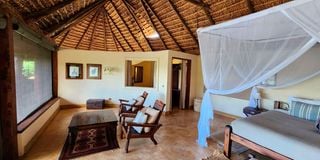Return to Elsa’s Kopje

One of the rooms at the Elewana Elsa’s Kopje lodge, perched atop Mughwango Hill at the centre of Meru National Park.
Meru National Park has long been one of my favourites. Perhaps it’s the relative remoteness and lack of crowds, but I also consider it one of the prettiest parks in the country, too. It should be harsh and dry, covered in impenetrable thickets of Commiphora, Combretum and Terminalia bush.
However, there are over a dozen ribbons of water, emanating from springs or rainfall on the Nyambene Hills, all feeding into the Tana river at the southern tip of the park.
These create linear oases with lush riparian woodland and thus plentiful shade and drinking water for a variety of wildlife species that would otherwise struggle to survive there.
I first visited Meru in August 2008 and last visited in September 2022. In both instances the rains had failed for over a year. Away from the rivers, the park was a barren brown and grey, but wildlife still thrived, adapted to these conditions, supplemented by the permanent streams.
This year, the rains had arrived in April with a vengeance. Within weeks, the whole park was transformed into a green wonderland, with every tree in leaf and the ground covered in grasses, wildflowers and an insect explosion. We arrived two weeks ago to find the park even prettier than ever!
Many of the roads were overgrown as a result, and getting around the park meant sticking to the well-maintained arterial routes. Large animals tend to spread out in the wet season, as food and water is plentiful across the whole region.
What mammals were left were also harder to spot, easily hidden by the wall of vegetation. Despite this, my friends and I couldn’t stop commenting on how amazing and under-appreciated the park seems to be.
We were staying at the Elewana Elsa’s Kopje lodge, perched atop Mughwango Hill in the centre of the park. The views from the pool area are spectacular and with binoculars we were able to spot dozens of Reticulated giraffe, Common zebra, buffalos and the odd elephant bull from above. Birdlife at this time of year is also at its densest, with migrants heading back for the northern summer months and residents feasting on all the insects, fruits and seeds after the rains.
Elsa’s Kopje is named after the lioness from Joy Adamson’s book, Born Free. The lodge still heavily features artefacts and photographs from this famous period in the park’s history. However, since Elewana took over ownership there has been a soft-refurbishment and as my Dad commented on the food at one of the sister properties, Loisaba Tented Camp, the culinary offerings are modern and also excellent.
A quirk of the lodge is that each room is unique, having been built in and around the trees and rocks on the hillside. All feature thatched roofs, stone floors and mosquito-netted walls, but their shape and incorporation of their ensuite bathrooms are all different.
There are a pair of two-bedroomed private units, too, one of which has its own pool. Most rooms have commanding views of the park below, but it’s no surprise that some travel agents and repeat guests have their favourites!
Like we did with the family at Loisaba, my friends and I were taking advantage of the Elewana Collection’s current offer to East African citizens and residents – until the end of May, you can stay three nights for the price of two. You can contact your local travel agent or [email protected] to enquire about the special.
Getting there by road does take a while, but we found the route through Ura Gate, turning off just north of Embu, at least an hour quicker than going through Meru or Isiolo. The road requires good clearance and if there are heavy rains, some river crossings might be treacherous. Best to check with the lodge just before travelling to determine which route is best at the time.
Andreas is Managing Director at Mbweha Training and Trails.





